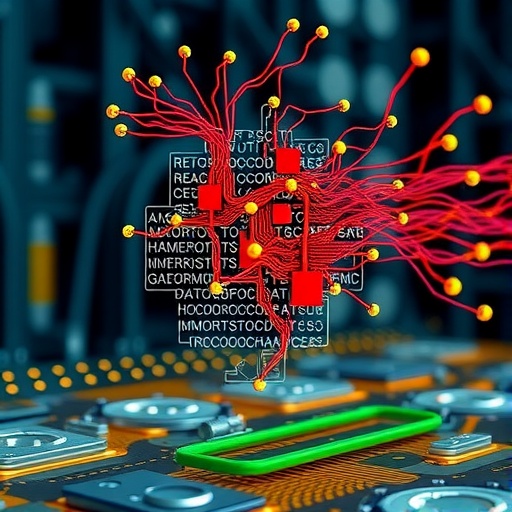In a groundbreaking stride towards refining neuromorphic computing, researchers have pioneered a novel in-sensor reservoir computing device rooted in tin disulfide (SnS₂), which adeptly navigates the challenge of recognizing motion dynamics across multiple timescales. Traditional electronic systems grapple with differentiating movements at varied speeds due to inherent limitations in their dynamic response range—a bottleneck this innovation seeks to overcome through sophisticated optoelectronic mechanisms embedded directly within the sensing hardware.
Central to this advancement is the SnS₂-based memristor, a component engineered via precision chemical vapor deposition techniques. This device harnesses the unique interplay of photogenerated carrier trapping and recombination at intrinsic defect sites within the material, yielding a tunable conductance that sensitively adapts to distinct illumination durations. Such a setup enables the memristor to instantaneously respond to rapid changes in light intensity, thus capturing fast-moving objects, while simultaneously manifesting synapse-like behavior for the analysis of slower motions, thereby accommodating a wide spectrum of temporal dynamics with remarkable flexibility.
The researchers report exceptional optoelectronic metrics for the SnS₂ memristor, including an unprecedented responsivity quantified at 208.9 amperes per watt, an external quantum efficiency soaring beyond 700%, and an impressive detectivity on the order of 10¹¹ Jones. These parameters underscore the device’s superior sensitivity and its aptitude for precise optical signal transduction, which are critical for enabling real-time, adaptive motion recognition directly at the sensory front end.
A pivotal innovation lies in the system’s ability to strategically modulate light intensity based on the velocity of the observed motion. Fast-moving entities are probed under low-intensity illumination, eliciting swift optoelectronic responses that capture transient spatial-temporal features with high fidelity. Conversely, slow-moving targets benefit from intensified light input, provoking prolonged dynamic responses analogous to biological synaptic functions, which enhance the detection of gradually evolving inputs. This dual-regime light adaptation remedies the prevalent issues of signal saturation and loss that plague standard fixed-response configurations.
The practical efficacy of this neuromorphic system was rigorously evaluated through dynamic motion recognition tasks utilizing the widely recognized Weizmann video dataset. In these trials, the in-sensor reservoir achieved flawless classification performance across diverse activities — notably running, side jumping, and walking — performed at varying velocities. Remarkably, this was accomplished with a significantly streamlined computational load, as the model required minimally 20,739 parameters, far fewer than those demanded by traditional long short-term memory (LSTM) networks.
This amalgamation of sensing, memory storage, and information processing within a singular hardware platform effectively bypasses the von Neumann bottleneck, a long-standing hurdle in conventional computing architectures characterized by separation of processing and data storage units. By unifying these operations, the SnS₂ memristor-based system delivers enhanced computational efficiency and paves the way for energy-efficient, edge-localized intelligence services—imperative for autonomous robotics and embedded AI systems operating in dynamic real-world environments.
Despite these striking results, the research team acknowledges that scaling the technology to high-resolution and more complex datasets, such as UCF101 which encompasses a wide array of human action recognition scenes, remains an open challenge. Future work will address scalability concerns and improve robustness in more cluttered, naturalistic scenes, propelling this hardware neuromorphic approach closer to broad applicability in intelligent machine vision.
The scientific rigor behind the project stems from the collaboration of several experts, including Linfeng Sun, Zhongrui Wang, and their colleagues at Beijing Institute of Technology. Their multidisciplinary efforts meld materials science, device physics, and computational neuroscience, illustrating the transformative potential of integrating optoelectronic memristors within neuromorphic frameworks.
This research was bolstered by substantial funding support, including grants from the Beijing Natural Science Foundation and China’s National Key Research & Development Plan, alongside contributions from Hong Kong’s Research Grants Council and Shenzhen’s Science and Technology Commission. Such backing underscores the strategic priority assigned to developing next-generation sensors and computing platforms.
Published in the journal Cyborg and Bionic Systems on September 30, 2025, the paper titled “Tunable Neuromorphic Computing for Dynamic Multi-Timescale Sensing in Motion Recognition” marks a significant milestone in the journey toward intelligent, adaptive sensory hardware capable of real-time environmental interaction. The DOI for this publication is 10.34133/cbsystems.0412, providing extensive technical details for further scholarly reference.
Beyond its immediate utility in motion recognition, this technology holds promise for widespread deployment in scenarios requiring rapid, on-site processing of complex sensory data under constrained power budgets—a cornerstone for the evolution of autonomous systems. By enabling hardware-level temporal dynamics tuning within a compact device, it redefines what is achievable in neuromorphic hardware design and implementation.
The implications extend toward revolutionizing edge-computing devices, potentially influencing sectors ranging from security surveillance to wearable health monitors and adaptive robotics. This SnS₂ memristor device stands as a beacon of innovation, bridging material science breakthroughs with real-world computational needs and setting the stage for a new era of smart sensors that effectively mimic biological sensing and processing strategies at previously unattainable performance levels.
Subject of Research: Neuromorphic computing with SnS₂-based in-sensor reservoir devices for dynamic motion recognition
Article Title: Tunable Neuromorphic Computing for Dynamic Multi-Timescale Sensing in Motion Recognition
News Publication Date:




